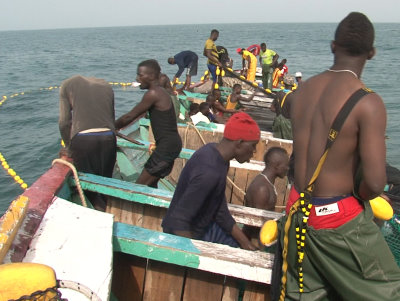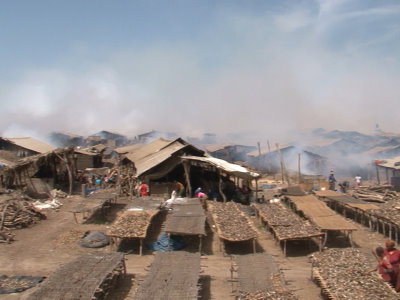 We wanted to screen this film, which we had the pleasure to co-sponsor, on March 16, 2018 at Mundo B in Brussels. The film, as described in the article by Alain Le Sann, focuses on the community of Kafountine, which in the space of a few years has gone from a Casamance tourist center close to The Gambia to the most dynamic fishing center on the Senegalese coastline.
We wanted to screen this film, which we had the pleasure to co-sponsor, on March 16, 2018 at Mundo B in Brussels. The film, as described in the article by Alain Le Sann, focuses on the community of Kafountine, which in the space of a few years has gone from a Casamance tourist center close to The Gambia to the most dynamic fishing center on the Senegalese coastline.
Kafountine, which has become what it is today, illustrates the speed with which the pressure on the resources of the different ecosystems increases, calling into question for how long the dependence of the populations can last in relation to the different services that their ecosystems provide: this is, for example, a worry for important aquatic and forest environments.
The screening of the film attracted a diverse audience including some members of the Senegalese community based in Brussels, experts and technicians working in the field of fisheries and / or sustainable management particularly of marine ecosystems. A few students in the free course given the day before also made it to the screening.
Beginning at 18:00, the screening ended around 19:00, followed by a debate. The exchanges focused mainly on a further contextualization of the documetary that interested the public.
To start with, the film shows that Kafountine has become perhaps the last safe haven for migratory movements of people following the fish at sub-regional scale. They are forced to abandon the north of Senegal (Joal, St Louis, Bargny ...), largely because of the establishment of fish meal plants and exporting factories in the North of the country. It is overexploitation, climate change and the higher purchasing power of these factories that has diminished or even destroyed the economic base of artisanal fisheries in the north. This in turns causes new pressures on ecosystems in Casamance in the south, including the marine environment, the mangroves and the forest.
It is overexploitation, climate change and the higher purchasing power of these factories that has diminished or even destroyed the economic base of artisanal fisheries in the north. This in turns causes new pressures on ecosystems in Casamance in the south, including the marine environment, the mangroves and the forest.
Although this demographic pressure around Kafountine creates a major governance problem, it is above all these authorizations by administrations to set up feed factories that have caused greater competition in the African domestic market for food. This direct competition between industrialists and artisans, between fish for human consumption and animal feed, is at the root of fish supply problem for many processors and traders serving local and subregional markets.
Secondly, one can easily see through the images of this film the deficit (from different angles) in the capacity of the authorities to regulate the way and the rhythm with which these resources are extracted so as to ensure their conservation and sustainable use.
The authorities in charge of water and forests (Service Eaux et Forêts), supposed to protect the flora which is currently subject to a strong unregulated exploitation, express their good will, but one senses an admission of helplessness on their part.
As the market demand is often the factor that "boosts" the rate of exploitation of a given resource, the ecosystems of Casamance, including those in the municipality of Kafountine suffer from excessive use of wood to process almost industrial quantities of fish by drying and smoking to be transported to the ECOWAS markets.
 Indeed, if eating smoked fish is part of the culinary traditions in most of the ECOWAS countries, the use of wood for this technique (which does not even spare the mangroves despite their crucial role for coastal protection) constitutes a real scourge. This needs to be tackled by trying not only to put in place legislation capable of saving what can still be, but also to propose alternatives in terms of new technologies that are effective and adapted so as to make a substantial saving in the quantities of wood previously needed for the smoking process.
Indeed, if eating smoked fish is part of the culinary traditions in most of the ECOWAS countries, the use of wood for this technique (which does not even spare the mangroves despite their crucial role for coastal protection) constitutes a real scourge. This needs to be tackled by trying not only to put in place legislation capable of saving what can still be, but also to propose alternatives in terms of new technologies that are effective and adapted so as to make a substantial saving in the quantities of wood previously needed for the smoking process.









